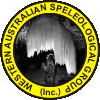By Rauleigh Webb
Minimal Impact Caving Code (MICC)
The MICC was accepted 24 months ago at the ASF conference in Victoria. Last year I reported that I felt that attitudes had changed very little during the prior 12 month period. At the end of 1996 little has altered to change my opinion. If anything I continue to dispair at the rate of damage to fragile cave systems. Cavers are still exploring, new, extremely low energy cave systems with techniques reminiscent of the 1960's.
It was clear at the end of 1995 that ASF members have either not read the MICC or do not believe that it is necessary. Events in early 1996 where two "new" fragile cave systems were track marked by the surveyors only to have ALL of the track marking removed by subsequent cavers can only be classed as caver vandalism. These actions have and will result in considerable damage to both caves which would have been avoided if the track/route marking had been maintained. Strong action should be taken against the perpetrators before cave managers begin to group all cavers into the vandal category and remove our access rights to caves.
To ensure that ASF cavers are aware of the MICC and what it contains, a waterproof leaflet has been produced detailing the MICC and the Code of Ethics. This will be distributed to clubs in prior to the ASF conference in 1997. The costs were borne by a donation specifically for this purpose.
Cape Range Marina
The limestone required for the marina development was obtained from a quarry near Exmouth. The mining company engaged Darren Brooks, a local WASG member, to make assessments of any caves found as a result of the quarrying activity.
In late 1996 such as cave was found (Quarry Cave) and Darren examined the cave and found a significant bone deposit. He reported his find to the WA Museum and the mining company. Before the WA Museum had time to arrange a trip to examine the bone deposit more carefully the cave was severely damaged as a result of blasting of the quarry face to within a short distance of the cave entrance. Darren reported this to the WA Museum staff, the mining company, the Department of Environment Protection and the Department of Transport. The mining company was ordered, by the DEP, to halt quarrying activities at or near the cave. Unfortunately when WA Museum staff examined the cave the main chamber was severely damaged and the bone deposit could not be accessed.
Until stringent clauses are placed in conditions of mining that cause the immediate session of mining if a cave is discovered or breached then caves such as Quarry Cave will continue to be destroyed. Approaches will be made to the DEP to attempt to ensure that such protection is afforded to caves found as a result of quarry activities.
Cape Range Limestone Mine and Quicklime Plant
During 1996 an amazingly comprehensive report (given the short time available) was prepared by Elery Hamilton-Smith, Andy Spate and Kevin Keirnan on the significance of the Cape Range caves and karst for the DEP. This report detailed many of the shortcomings of previous work and highlighted the world significance of the Cape Range by recommending World Heritage Listing. Attempts were made by the DEP to keep the report secret and not to release its findings. Fortunately the report was leaked to the press and page one headlines ensued. Accusations flew thick and fast for about a week as the government was severely embarrassed by the reports findings.
The final decision of the DEP regarding the Limestone Mine and Quicklime Plant will be released early in 1997. At the time of writing (10 March 1997) it had not been released. This issue is likely to be a major one for the ASF if the DEP rules that the mine is to proceed in its current location.
Leeuwin-Naturaliste National Park (LNNP)
Permit System
The department of Conservation and Land Management (CALM) has stopped listening to caver input into cave management issues in the Leeuwin-Naturaliste National Park via the Cave Management Advisory Committee (CMAC). As a result the proposed assessment of the now 500+ non caving club leaders is not likely to proceed despite considerable effort by members of the caving community.
The proposal to develop Calgardup and Giants caves as locked self-guided caves generated two complete proposals as well as a submission from the Augusta Margaret River Tourism Association (AMRTA) to run a booking system for the caves and to conduct commercial tours.
A rewrite of the original CALM proposal attempts to alter the entire permit system by proposing fees of $7 (adults) and $4 (children) for all of the 15 self guided caves in the LNNP. This proposal has the potential to provide considerable funds for CALM to employ cave guides and managers. It also has the potential to destroy the permit system with leaders caving without permits in protest at the pricing structure. Juggling these two balls will be a large challenge for CALM managers. Results next year?
Track/Pathway Development and Restoration Work
A major stairway has been constructed in Calgardup Cave. Despite the development of a site working plan for the cave the development of the cave was conducted on an ad-hoc basis resulting in considerable overdevelopment with the use of incorrect materials resulting in unnecessary cave pollution.
An abseiling platform is in place over the Calgardup Cave solution pipe. This platform has reduced the damage at the site to almost zero. Restoration work is still required.
Considerably more work is required at a number of the sites in the LNNP before caves will stop being degraded.
Lake Cave Interpretive Centre - CaveWorks
The Interpretive Centre at Lake Cave called CaveWorks will be officially opened on 22nd February 1997. The centre developed with a large Australian Tourism Commission grant, considerable monies from other government agencies and the AMRTA is set to be the center for caver education in the South-West.
The efforts of the AMRTA in taking the concept, originally from the CMAC, and turning it into reality must be applauded loudly. Caves can only benefit from the education of cave visitors.
Nullarbor World Heritage Listing
The election of the liberal government placed the proposed listing in limbo. No new developments have occurred since the WA liberal government was elected. Same status as 1994.
South Coast Management Plan
As at February 1997 none of the proposed National Parks or reserves in the Nullarbor region have been declared. The required legislation is STILL LOST (I have stated the same thing for the last 6 years!) in government mumbo jumbo! This has now worsened as a result of the Mabo and Wik decisions.
Weebubbie Cave was closed to visitors in late 1996 by the Department of Land Administration (DOLA) as a result of a mining engineer's report on a rockfall that occurred in the cave. By January 1997 the ASF had negotiated access to Weebubbie Cave for ASF leaders. This result was only achieved because of the comprehensive nature of the ASF public liability insurance. Details of how access is obtained will appear elsewhere.
Last year I indicated that the number of features on the Nullarbor had doubled since 1994. During the past 12 months the numbering of features has continued to increase with over 1600 features now numbered. While the number of new caves is significant the documentation, track marking and surveying of these features continues to be poor. Those cavers responsible for finding caves should also act responsibly and undertake follow up work on their finds. The lack of surveys and track marking is resulting in damage to a significant number of new caves.
Yanchep National Park
Groups with no caving experience have been given access to caves in the Yanchep National Park despite the protests of recognised caving groups. This management decision appears to have occurred at a very high level within CALM. Hence the major concern as it shows a considerable lack of understanding regarding the fragility of the cave resource.
Attempts will be made to try and reverse this disturbing management decision.
Nambung National Park
The draft Management Plan was released for comment during 1996 and the ASF responded with the following recommendations for alteration or inclusion in the final plan:-
The Federation proposes the alteration of the recommendations from Section 5 of the draft Nambung National Park management plan to read:-
1. Consider the vulnerability of geological features, landforms and soils in all management operations, such as new access, firebreaks, fire management plans, catchment alterations and site developments.
2. In consultation with speleological groups, complete a resource inventory, classification system and access policies for caves and karst features in the area.
3. Liaise with speleological groups and other karst management specialists regarding management and other operations that are likely to impact on karst features.
The Federation proposes the following additional recommendation for Section 6, Hydrology:-
Consult with other government agencies and adjacent land owners to devise land use agreements to ensure the long term conservation of river catchments.
The Federation proposes that the following additional recommendation be added to Section 11 under Prescribed Burning:-
3. Burn Plans will contain edge burns at identified cave and karst sites that are considered highly vulnerable to damage from fires.
The Federation proposes that an additional recommendation be added to section 13 Introduced Plants and Animals:-
3. Sensitive cave and karst sites will be monitored for introduced species and eradicated as soon as practicable.
After checking with the ranger in charge at Nambung National Park it was found that the final plan is still under preparation and should be released during 1997.
Drovers Cave National Park
No management plan has been prepared for the park and one is not likely in the near future. This lack of management plan leaves issues such as the impact of adjacent land clearing on caves in the park in limbo.
The ASF opposed a significant land clearance on a large block adjacent to the Drovers Cave National Park as it is considered to be the catchment for Old River Cave. This cave is the largest cave in the park and the only known cave in the park with an active streamway. The massive land clearance is expected to have a significant effect on the water levels within the cave.
The DEP report on the proposed land clearance recommended that the clearance be given the go ahead with a number of minor monitoring restrictions. Unfortunately no monitoring was proposed in Old River Cave despite ASF recommendation to the contrary. The ASF has appealed the decision and the current status is that we are awaiting the outcome of the appeal.
A proposal is being derived to "open" the gate and other cemented closed solution pipes on Drovers Cave so that air movement can be restored to the cave and hopefully bats will return to the cave. This proposal is currently stalled on the design of the future gate. Further developments are anticipated in 1997.

